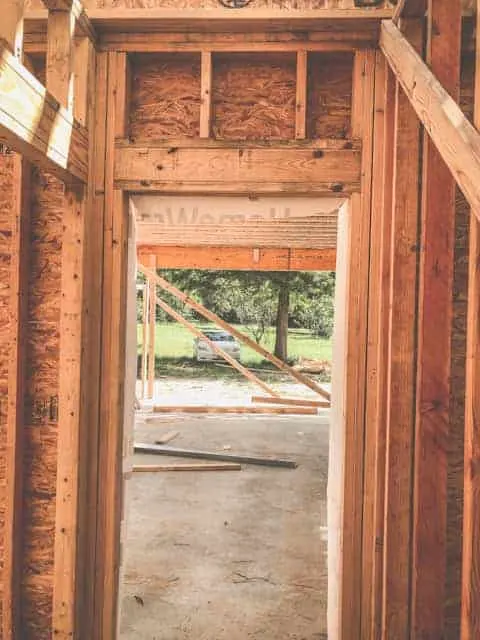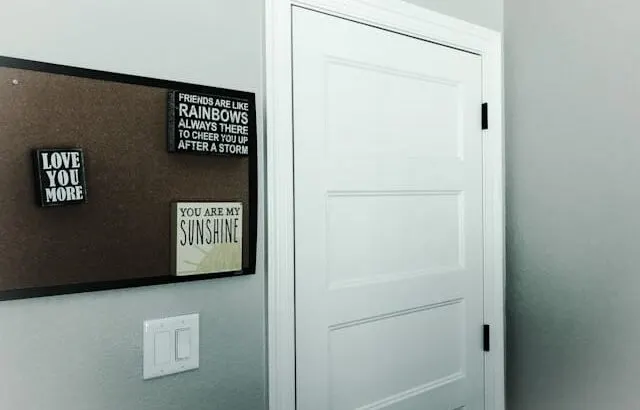Perhaps you have noticed a strange phenomenon when doors close in your home. Instead of closing with a gentle, quiet click, they cause the whole wall to shake and vibrate, maybe even involuntarily slamming the door in the process. It can be disconcerting to have the wall shake and can even cause damage to property, like knocking pictures off the wall.
Why does a wall shake when the door closes? The two primary reasons that closing a door will cause a wall to shake are:
- improper door framing
- negative air pressure
Older homes and DIY renovations tend to have issues with improper framing while in newer homes it is more likely to be negative air pressure causing the issue.
Both causes come with specific challenges. This article will explain the issues and offer solutions to the shake.
Reason One: Improper Door Framing
Underneath the drywall and trim of your wall, a myriad of wall studs and framing exists. When a door is installed in a wall, it should have extra support built into the sides and top to support the unit. In proper door framing, several components should exist: (source)
- King studs: These studs frame the entire door structure by extending vertically from the door plate to the top plate. They provide stabilization of the door unit.
- Jack studs: These studs make up the vertical door frame. They are secured to the king studs and the door is secured to them. (Some advanced framing techniques leave out this stud and attach the door directly to king stud.)
- Header: The header is the horizontal piece that connects the king studs together at the top of the door frame. They provide structural support and stability to the door frame.
- Top Plate: The top plate runs horizontally along the ceiling. The king studs are attached to it.

If the door was installed as part of new construction, it probably has all of these necessary components as per normal building code, unless the home is older or built without all building code inspections. Some do-it-yourself older homes may not have been built with all codes up to par.
However, the most common problem lies with post-construction door additions. If the door was installed as part of a remodel, sometimes the king studs are not installed, causing the door to basically float in the wall with little structural support. Although it is attached to the floor via the jack studs, it does not have upper support.
So back to the wall shaking problem: when the vertical frame only runs to the header of the door frame, there is little structural support to support the door. The force exerted on the door and wall when it closes is not supported and therefore the force causes the whole wall to shake and vibrate.
What Can You Do About Improper Framing?
You have two options, and probably only one is appealing. You can tear the wall apart and add king studs, or you can install devices to lessen the shake. Unless you are working on a remodel already, the second option is much less invasive. A few products are available to help with this issue (Links are to Amazon):
- Hydraulic Auto Door Closer: Products like this are usually used in businesses on heavy glass doors or exterior doors. However, you could install one on your home’s interior and exterior doors.
With speed control valves, a hydraulic door closer controls the speed at which the door closes, which could stop the wall from shaking from the excess force. - Gel Bumpers: Similarly, gel bumpers absorb some of the shock of a door closing and could potentially reduce the shaking wall syndrome. Install them along the frame of the door to provide a cushion for the door. They may not withstand exterior elements, but for interior doors, they are a viable option.
I’ve used these extensively through my current and previous homes for interior doors as well as cabinet doors and drawers. They work great for this and are inexpensive.
- Weatherstripping: Weatherstripping would also dampen the door’s force on closure, lessening the vibrations. It has the added benefit of providing some insulation, especially for an exterior door application.
My recommendation would be to try weatherstripping on exterior doors and gel bumpers on interior doors, depending on where you are having the issue.
Reason Two: Negative Pressure
The problem of negative pressure is a little more complicated and quite common in newer homes built with very high airtight standards.
Over the past 40 years, homes have become increasingly airtight, which creates some unique challenges and concerns.
What is Negative Pressure?
First of all, let’s discuss air pressure. Air pressure is the pressure exerted on a container (your home) due to the compression of gases in and around it.
- When a container has more air inside of it than the surrounding area, it causes the air to try to escape the container and neutralize the pressure.
- When the container has less air inside of it than the outside environment, it causes air to rush into the container, again in an attempt to neutralize pressure.
When the container, or in this case a house, has less air inside than outside, it is said to have negative pressure. Air from outside will try to find a way in to neutralize the pressure difference.
If this is happening unintentionally, it is called infiltration. If it happens in a controlled and intentional way, it’s called ventilation.
Infiltration can be caused by high winds, mechanical equipment in the home, and the stack effect. The stack effect is caused by warm air rising inside and escaping from vents and other leaks. Cold air from outside then infiltrates the lower sections of the home to fill the void.
When the house has more air inside than outside, or positive air pressure, then air attempts to escape the home in any way possible. This is called exfiltration.
Exfiltration can be caused by air forced out of the home through exhaust fans or natural airflow through cracks and leaks.
In a standard-built home, a small amount of infiltration and exfiltration occurs naturally through small leaks, cracks, fans, and openings.
Now, the problem with airtight homes is they create negative pressure environments. This may not seem like a bad thing, but it can actually cause some pretty serious health concerns and maintenance issues.
Problems with Negative Air Pressure
In a negative pressure environment, air is always trying to find a way into the building, but in an airtight home, this is almost impossible. Because very little fresh air enters the building, this can cause:
- High levels of dangerous gas buildup, such as carbon monoxide and radon
- Back drafting of combustion appliances
- Mold and mildew growth from high levels of humidity
- Bad smells and stagnant air
- Cold drafts
As you can see, negative air pressure is much more sinister than simply causing your wall to shake. A home is actually healthier with a slightly positive pressure to help force air to exit the building envelope. You can achieve this through adequate ventilation.
Why Does Negative Pressure Cause My Door to Shake?
In homes that are tightly insulated and air sealed, the pressure within the home has nowhere to escape when a door closes. You are basically forcing one room to pressurize differently than the one next to it, and the result is vibration and shaking as the room adjusts.
The pressure differential produced by imbalanced airflow can cause doors to even slam against your will (source).
You can test this issue by opening a window in the space. Now close the door as normal. If the wall doesn’t shake, then you are dealing with a pressure imbalance within your home.
Alternatively, try cracking the door and feeling if wind is rushing into or out of the space. This would also indicate an airflow issue.
What to Do About Negative Pressure
If you suspect negative pressure from an airtight home is causing your walls to shake upon the door closing, you can do a couple things to mitigate the problem.
The first thing you can do is install a door closer, gel bumpers, or weatherstripping just like in the framing section. This should stop or reduce the wall shake.
However, if you would like to think more holistically about the negative pressure issues, make sure a ventilation system is installed and working properly on your home.
Proper whole-house mechanical ventilation systems, such as fans, humidifiers, and air conditioning units, should allow for neutral or slightly positive pressure within the home. These systems can provide heat recovery, humidity control, and air filtration (source).
Conclusion
Walls shaking when a door shuts inside the home is a fairly common problem and is usually caused by improper framing techniques or negative pressure within the home. In either case, you can install some simple devices to lessen the shaking, such as door closers or gel bumpers.
But for a more thorough solution, you either have to reframe the door or work on proper ventilation systems.
If the door is reframed with structural support from floor to ceiling, the wall will not have to take the force. Likewise, ventilation systems will correct the pressure imbalances in the home that can cause health issues in addition to the shaking walls.
As a homeowner, I am constantly experimenting with making the structure of my house more energy-efficient, eliminating pests, and taking on DIY home improvement projects. Over the past two decades, my family has rehabbed houses and contracted new home builds and I’ve learned a lot along the way. I share my hard-learned lessons so that you can save time and money by not repeating my mistakes.


Leave a comment
You must be logged in to post a comment.